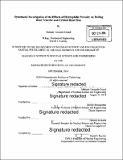| dc.contributor.advisor | Jacopo Buongiorno and Thomas McKrell. | en_US |
| dc.contributor.author | Tetreault-Friend, Melanie | en_US |
| dc.contributor.other | Massachusetts Institute of Technology. Department of Nuclear Science and Engineering. | en_US |
| dc.date.accessioned | 2015-02-25T17:10:52Z | |
| dc.date.available | 2015-02-25T17:10:52Z | |
| dc.date.copyright | 2014 | en_US |
| dc.date.issued | 2014 | en_US |
| dc.identifier.uri | http://hdl.handle.net/1721.1/95571 | |
| dc.description | Thesis: S.M., Massachusetts Institute of Technology, Department of Nuclear Science and Engineering, 2014. | en_US |
| dc.description | Cataloged from PDF version of thesis. | en_US |
| dc.description | Includes bibliographical references (pages 97-99). | en_US |
| dc.description.abstract | Predicting the conditions of critical heat flux (CHF) is of considerable importance for safety and economic reasons in heat transfer units, such as in nuclear power plants. It is greatly advantageous to increase this thermal limit and much effort has been devoted to studying the effects of surface characteristics on it. In particular, recent work carried out by O'Hanley demonstrated the separate effects of surface wettability, porosity, and roughness on CHF, and found that porous hydrophilic surface coatings provided the largest CHF increase, with a 50-60% enhancement over the base case. In the present study, a systematic investigation of the effects that the physical characteristics of the hydrophilic layers have on heat transfer was conducted. Parameters experimentally explored include porous layer thickness, pore size, and void fraction (pore volume fraction). The surface characteristics are created by depositing layer-by-layer (LbL) thin compact coatings made of hydrophilic SiO₂ nanoparticles of various sizes. A new coating was developed to reduce the void fraction by using polymers to partially fill the voids in the porous layers. All test surfaces are prepared on indium tin oxide - sapphire heaters and tested in a pool boiling facility at atmospheric pressure in MIT's Thermal-Hydraulics Laboratory. Results indicate that CHF follows a trend with respect to each parameter studied and clear CHF maxima reaching up to 114% enhancement are observed for specific thickness and pore size values. ZnO₂ nanofluid-generated coatings are also prepared and their boiling performance is compared to the boiling performance of the engineered LbL coatings. The results highlight the dependence of CHF on capillary wicking and are expected to allow further optimization of the nanoengineered surfaces. | en_US |
| dc.description.statementofresponsibility | by Melanie Tetreault-Friend. | en_US |
| dc.format.extent | 99 pages | en_US |
| dc.language.iso | eng | en_US |
| dc.publisher | Massachusetts Institute of Technology | en_US |
| dc.rights | M.I.T. theses are protected by copyright. They may be viewed from this source for any purpose, but reproduction or distribution in any format is prohibited without written permission. See provided URL for inquiries about permission. | en_US |
| dc.rights.uri | http://dspace.mit.edu/handle/1721.1/7582 | en_US |
| dc.subject | Nuclear Science and Engineering. | en_US |
| dc.title | Systematic investigation of the effects of hydrophilic porosity on boiling heat transfer and critical heat flux | en_US |
| dc.type | Thesis | en_US |
| dc.description.degree | S.M. | en_US |
| dc.contributor.department | Massachusetts Institute of Technology. Department of Nuclear Science and Engineering | |
| dc.identifier.oclc | 903548163 | en_US |
